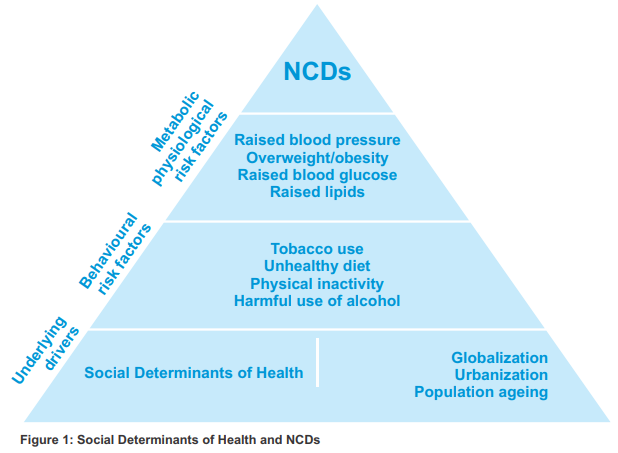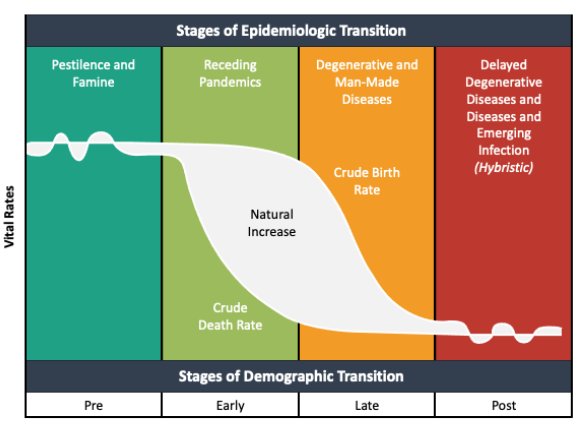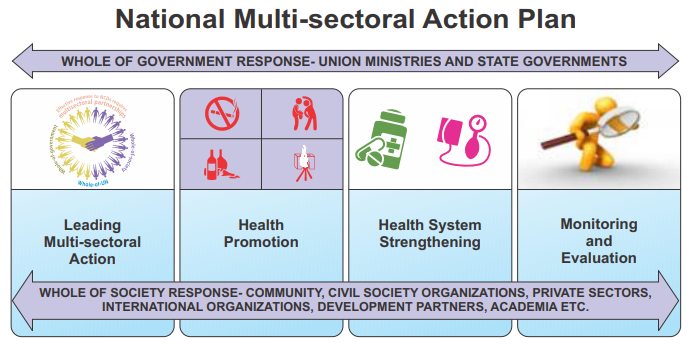Non-Communicable Diseases (NCDs)
2023 SEP 29
Mains >
Social justice > Health > Health
IN NEWS:
- At least 4.6 million deaths in India can be averted by 2040 if half of the people with hypertension manage to keep their blood pressure under control, said the recently released first-ever report by the World Health Organisation on the devastating global impact of high blood pressure.
- Also, the report found that uncontrolled hypertension is the reason for 52% of the deaths from cardiovascular diseases (one of the major types of non-communicable diseases) like heart attacks and strokes in India.
HIGHLIGHTS OF THE WHO REPORT:
- An estimated 33% of the global population lives with hypertension, with just over half receiving a diagnosis, as per the report.
- The report said 188.3 million people in India were living with the hypertension, but only 37% of these were aware of their status.
- And many do not start their treatment even after diagnosis.
- Only 30% of the estimated people living with hypertension start treatment, while only 15% manage to keep their blood pressure under control.
- The report also said that 34% of adults are physically inactive in the country, 4% are obese, and 28% smoke or chew tobacco
NON-COMMUNICABLE DISEASES:
- Non-communicable diseases (NCDs) are medical conditions or diseases that are not caused by infectious agents. These are chronic diseases of long duration, and generally slow progression.
- The main types of NCD are cardiovascular diseases (such as heart attacks and stroke), cancers, chronic respiratory diseases (such as chronic obstructive pulmonary disease and asthma) and diabetes.
WHAT CAUSES NCDs:
NCDs are the result of a combination of genetic, physiological, environmental and behavioural factors.

- Tobacco use: chewing, smoking, second-hand smoke, and smokeless tobacco
- Unhealthy diet: diets low in fruit, vegetables, and whole grains, but high in salt and fat
- Harmful use of alcohol
- Physical inactivity
- Air pollution: both outdoor air pollution and household air pollution
- Genetics: Eg: Type 2 diabetes can be inherited
- Epidemiological transition: The epidemiologic transition describes changing patterns of population distributions in relation to changing patterns of mortality, fertility, life expectancy, and leading causes of death.

STATISTICS:
- Worldwide, NCDs cause 74% of all deaths, surpassing the toll of infectious diseases.
- Diabetes is one of the most common NCD
- Over 60.46 lakh people died due to NCDs in India in 2019, which accounts for 66 per cent of total deaths, according to the WHO report.
- The report further revealed that there was a 22% probability of death between the age of 30 and 70 due to any type of non-communicable disease.
- But global adoption of right policies can prevent 39 million deaths by 2030, the WHO noted.
CHALLENGES:
- Ageing population:
- The incidence of NCD and mortality increased with age. The elderly population (aged 60 years or above) in India accounted for 8.6% of the total population in 2011. This number is expected to increase by 40% to 195 million in 2031.
- Limited political attention:
- NCDs are recognised as a public health emergency in slow motion. However, the agenda for health continues to be dominated by maternal and child health priorities and infectious diseases.
- Deficiencies in the health system:
- Excessive consumerism:
- Driven by unchallenged aggressive marketing strategies, the lifestyle of people has changed. This has resulted in tobacco use, alcohol abuse, excessive consumption of trans, sugar, salt and high-fat foods, especially saturated fats.
- Economic challenges:
- Due to absence of social security net and high out of pocket expenditures, NCDs severely affect the poor and vulnerable people of the society, forcing them into the abyss of poverty.
- Poor urban planning:
- Improperly or poorly managed urban planning has brought a significant increase in air pollution and sedentary living, thereby aggravating NCDs.
- Eg: a recent health report by ASSOCHAM states that 76% of the population with NCDs is exposed to high air pollution.
- Pandemic induced disruptions:
- Covid-19 highlighted the link between NCDs and infectious disease, with serious impacts on NCD care. In the early months of the pandemic, 75 per cent of countries reported disruption to essential NCD services.
GOVERNMENT EFFORTS:
I. INTERNATIONAL
- SDG Target 3.4:
- The Sustainable Development Goal target to reduce early deaths from NCDs by a third by 2030.
- WHO Global Action Plan for the Prevention and Control of NCDs 2013-2020:
- The Global Action Plan provides Member States, international partners and WHO with a road map and menu of policy options which, when implemented collectively between 2013 and 2020, will contribute to progress on 9 global NCD targets to be attained in 2025, including a 25% relative reduction in premature mortality from NCDs by 2025.
- India was the first country to adopt the National Action Plan
- WHO Framework Convention on Tobacco Control (WHO FCTC)
- The WHO FCTC is the first ever international public health treaty focusing on the global public health issue of tobacco control.
- WHO-FCTC provides for various measures to reduce the demand as well as supply of tobacco
- India ratified the treaty in 2004
II. NATIONAL:
- National Programme for Prevention and Control of Cancer, Diabetes, Cardiovascular disease and Stroke (NPCDCS)
- It was launched in 2010 as part of the National Health Mission (NHM)
- Objectives:
- Prevent and control common NCDs through behaviour and life style changes
- Provide early diagnosis and management of common NCDs
- Build capacity at various levels of health care for prevention, diagnosis and treatment of common NCDs
- Train human resource within the public health setup viz doctors, paramedics and nursing staff to cope with the increasing burden of NCDs
- Establish and develop capacity for palliative and rehabilitative care
- The NCD cell at various levels will ensure implementation and supervision of the programme activities
- Pilot project on 'Integration of AYUSH with NPCDCS' has been initiated in six districts in the country.
- While the global action plan has suggested 9 targets for countries to set, India created a tenth target to address household air pollution.
- National Multisectoral Action Plan for Prevention and Control of Common NCDs (2017-2022)
- It is a national blue print and will provide a clear direction to the nation's pursuit to tackle the growing burden of NCDs within the specific socio-economic, cultural and health systems contexts of the country.

- Indian Hypertension Control Initiative (IHCI):
- Indian Hypertension Control Initiative (IHCI) is a 5-year initiative involving the Ministry of Health & Family Welfare, Indian Council of Medical Research, State Governments, and WHO-India.
- The Government of India has adopted the "25 by 25" goal, which aims to reduce premature mortality due to non-communicable diseases (NCDs) by 25% by 2025.
- One of the nine voluntary targets includes reducing the prevalence of high BP by 25% by 2025.
- IHCI aims to accelerate progress towards the Government of India's NCD target by supplementing and intensifying evidence-based strategies to strengthen the building blocks of hypertension management and control.
- The initiative was launched in 2017 and expanded in a phased manner to cover more than 130 districts across 23 states.
- Other efforts:
- National Tobacco Control Programme:
- It was launched in 2007-08 with the aim to create awareness about the harmful effects of tobacco consumption, reduce the production and supply of tobacco products, ensure effective implementation of the Cigarettes and Other Tobacco Products Act, 2003.
- Ujjwala yojana:
- Eat right campaign:
- Fit India Movement:
CONCLUSION:
According to World Health Organization (WHO) projections, the total annual number of deaths from NCDs will increase to 55 million by 2030, if timely interventions are not done for prevention and control of NCDs. These can include:
- Raise priority accorded to NCDs in financial allocation and health system strengthening initiatives, with strong emphasis on primary care.
- Reduce the major modifiable risk factors, such as tobacco use, harmful use of alcohol, unhealthy diets, and physical inactivity.
- Increase access to affordable health systems through people-centred health care and universal health coverage.
- Promote research and development into the area of non-communicable disease prevention and care.
- Utilization of social media to improve patients’ awareness on NCDs.
PRACTICE QUESTION:
Q. Non-Communicable Diseases (NCDs) are an emerging public health concern. Discuss the factors that make India vulnerable to non-communicable diseases. What measures have the government taken to address the same?


